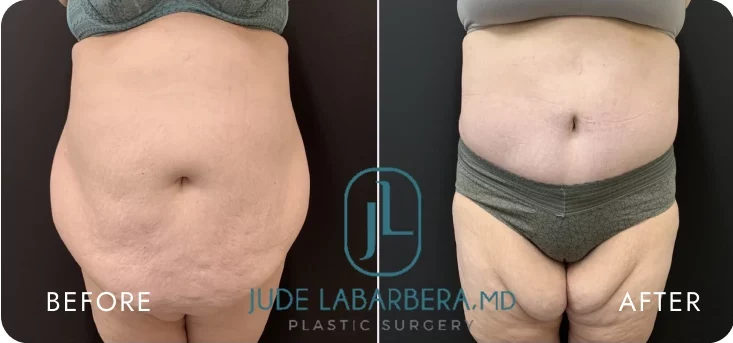Tummy Tuck for Plus-Size Women: What You Need to Know
For many women, the midsection is one of the most frustrating areas of the body to address. Even after dedicated efforts with diet and exercise, stubborn fat deposits, loose muscles, and sagging skin can persist. This is particularly true for plus-size women who may have carried extra weight for years or experienced significant changes from pregnancy. A tummy tuck, also known as abdominoplasty, can be a powerful option for achieving a smoother, firmer abdomen. But if you are plus-size, you likely have specific questions and concerns about whether this surgery is right for you.
This guide provides an overview of what you need to know about tummy tucks for plus-size women, including the procedure's details, potential risks to consider, and preparation tips for achieving optimal results.
Understanding Excess Skin and Its Challenges
A tummy tuck goes beyond simple fat reduction. The procedure removes extra skin, tightens abdominal muscles, and creates a flatter appearance. This combination makes it especially beneficial for women who struggle with hanging folds of skin that cannot be resolved with exercise alone.
The High-BMI Tummy Tuck: Is It Possible?
Some surgeons may prefer that patients lower their BMI before surgery to minimize complications. However, other specialists, such as Dr. LaBarbera, understand that not everyone can reach a “normal” BMI before considering surgery. In these cases, the surgeon assesses overall health, lifestyle habits, and realistic goals to determine candidacy.
Extended Tummy Tuck Options for Fuller Figures
Considering a Plus-Size Tummy Tuck
- Reduce the overhanging skin fold known as a pannus.
- Improve mobility by removing tissue that causes friction.
- Create a smoother waistline under clothing.
- Increase confidence in personal and social settings.
Should You Lose Weight Before a Tummy Tuck?
If you are actively on a weight-loss journey and expect to shed a significant amount of pounds, it may be best to wait until your weight stabilizes. Losing weight after surgery can result in new loose skin, which reduces the longevity of your results.
However, many plus-size women are at a stable weight but remain unhappy with their midsection. In such cases, surgery can proceed without waiting for further weight loss. Ultimately, your surgeon will guide you on the safest and most effective course of action.
Tummy Tuck as Part of Plastic Surgery for Plus-Size Patients
Body Contouring Benefits for Plus-Size Women
The term “body contouring” refers to surgical procedures designed to reshape and refine body proportions. For plus-size women, body contouring can provide both functional and aesthetic benefits. Removing heavy, sagging abdominal tissue can relieve back pain, reduce skin irritation, and improve posture.
A tummy tuck also makes it easier to engage in physical activities, which can encourage long-term health. Beyond the physical changes, many women experience a surge in self-confidence that positively influences relationships, work, and overall quality of life.
What to Expect With Post-Surgery Care
- Wearing compression garments to minimize swelling and support healing.
- Taking short, frequent walks to encourage circulation and reduce blood clot risk.
- Avoiding heavy lifting or strenuous activity for several weeks.
- Attending all follow-up appointments to monitor progress.
Choosing the Right Plastic Surgeon
Schedule a consultation with Dr. LaBarbera!
Setting Realistic Expectations
Patients who approach surgery with realistic expectations tend to be the most satisfied with their outcomes. They understand that while the procedure can dramatically improve confidence and function, it should be viewed as one part of an overall health and wellness journey.
The Procedure Explained
It’s natural to feel nervous about surgery, so here is the procedure explained step by step:
- Anesthesia – Most tummy tucks are performed under general anesthesia to ensure comfort.
- Incision – A horizontal incision is made across the lower abdomen below the bikini line.
- Muscle Tightening – If the abdominal muscles are stretched or separated, the surgeon will suture them together for a firmer core.
- Skin Removal – Excess skin and fat are removed, and the remaining skin is carefully redraped to create a smooth appearance.
- Navel Repositioning – In many cases, the belly button is repositioned to achieve a natural appearance.
- Closure – The incision is closed with sutures, and dressings or drains may be placed.
Understanding Increased Risks for Plus-Size Patients
- Delayed wound healing
- Infections
- Fluid buildup
- Blood clots
Schedule a Consultation With Dr. LaBarbera Today
Choosing the right surgeon is the foundation of a safe and satisfying tummy tuck experience. Dr. Jude LaBarbera is a board-certified plastic surgeon recognized for his advanced skills in body contouring and specialized procedures for individuals with larger body frames, including plus-size tummy tucks. He combines technical skill with an approachable, patient-focused style that helps women feel comfortable and confident.







